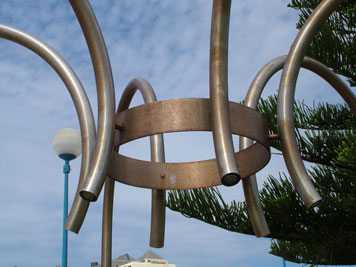Removing Tea Stains from Stainless Steel – Austral Wright Metals
 |
Application Data Sheet - Stainless Steel |
Removing Tea Staining |
Tea staining is overall surface discolouration of stainless steel due to superficial corrosion. It is mainly cosmetic, but is likely to progress to more serious corrosion, and it is wise to remove the staining as soon as possible after it has appeared. Tea staining can be avoided by selection of a suitable grade, surface finish, fabrication and installation practices and washing regime for the corrosion conditions. The ASSDA Technical Bulletin – Preventing Coastal Corrosion has more information – download it from http://www.assda.asn.au or ask Austral Wright Metals for a copy. Austral Wright Metals also provide advice on selection of grade and finish suitable for particular applications. When tea staining does occur, it is usually visible within a month or two – older installations are unlikely to be affected unless corrosion conditions change. It is wise to remove the staining within a few months after it appears, to prevent it progressing to more serious corrosion.
The stain can be removed with a mild acid (details overleaf). The resulting surface will be clean, and the original appearance of the stainless steel surface completely restored. Tea staining will return unless the conditions which caused it in the first place are changed: the simplest method is usually including the stainless steel in the washing schedule. It is obviously difficult to remedy inappropriate grade or surface finish selection, but problems with fabrication practice such as carbon steel contamination or inadequate weld cleanup should be remedied by the usual methods. Tea staining returns more slowly after each remediation treatment, and after a few treatments tea staining may not return. Of course inadequate grade selection or a rough surface may mean that treatment has to be repeated indefinitely. If tea staining is happening because the surface is much too rough for the environment, the options are to polish it to a smoother finish, or to passivate with a nitric acid based solution or paste, or both. Passivation will improve the corrosion resistance of the surface and greatly delay or eliminate the return of tea staining. Nitric acid increases the corrosion resistance of the surface without changing the appearance. Pickling with mixtures containing hydrofluoric or sulphuric acid will remove tea stains, but will also dull the surface of the stainless steel and leave it blotchy. Using these strong mineral acids, including pickling paste, is not recommended for removing tea staining. Lacquer, varnish or ‘polish’ are sometimes applied to the repaired surface to try to prevent the return of tea staining. These treatments are rarely effective outdoors, and must be maintained as they make a mess of the surface when they fail. This may involve removing the coating and recoating every few years. Lacquers should only be applied on very dry surfaces. Steps to Remove Tea Staining
|
The technical advice and recommendations made in this Product Data Sheet should not be relied or acted upon without conducting your own further investigations, including corrosion exposure tests where needed. Please consult current editions of standards for design properties. Austral Wright Metals assumes no liability in connection with the information in this Product Data Sheet. Austral Wright Metals supplies a comprehensive range of stainless steels, copper alloys, nickel alloys and other high performance metals for challenging service conditions. Our engineers and metallurgists will be pleased to provide further data and applications advice. |


